Heat Transfer Optimization of NEXA Ballard Low-Temperature PEMFC
Abstract
1. Introduction
2. Testing and Measurement Methods
3. Experimental and Simulation Results
FC CFD Heat Transfer Simulation and Cooling Duct Optimization
4. Conclusions
Author Contributions
Funding
Data Availability Statement
Conflicts of Interest
Abbreviations
| AEM | Anion-Exchange Membrane |
| CFD | Computational Fluid Dynamics |
| CL | Catalyst Layers |
| FC | Fuel Cell |
| FP | Flow Plates |
| GDL | Gas Diffusion Layers |
| HHS | Hydrogen Hybrid Energy System |
| HT | High-Temperature |
| IR | Infrared |
| LHV | Lower-Heating Value |
| LT | Low-Temperature |
| MH | Metal Hydride |
| PEM | Proton-Exchange Membrane |
| PtG | Power-to-Gas |
| PV | Photovoltaic |
| PVC | Polyvinyl Chloride |
| RES | Renewable Sources |
References
- Hirscher, M. Handbook of Hydrogen Storage: New Materials for Future Energy Storage; Wiley-VCH: Weinheim, Germany, 2009; ISBN 9783527322732. [Google Scholar]
- Ursúa, A.; San Martín, I.; Barrios, E.L.; Sanchis, P. Stand-alone operation of an alkaline water electrolyser fed by wind and photovoltaic systems. Int. J. Hydrog. Energy 2013, 38, 14952–14967. [Google Scholar] [CrossRef]
- Barbir, F. PEM electrolysis for production of hydrogen from renewable energy sources. Sol. Energy 2005, 78, 661–669. [Google Scholar] [CrossRef]
- Yilanci, A.; Dincer, I.; Ozturk, H.K. A review on solar-hydrogen/fuel cell hybrid energy systems for stationary applications. Prog. Energy Combust. Sci. 2009, 35, 231–244. [Google Scholar] [CrossRef]
- Yunez-Cano, A.; de González-Huerta, R.G.; Tufiño-Velázquez, M.; Barbosa, R.; Escobar, B. Solar-hydrogen hybrid system integrated to a sustainable house in Mexico. Int. J. Hydrog. Energy 2016, 41, 19539–19545. [Google Scholar] [CrossRef]
- Thomas, C.; James, B.D.; Lomax, F.D.; Kuhn, I.F. Fuel options for the fuel cell vehicle: Hydrogen, methanol or gasoline? Int. J. Hydrog. Energy 2000, 25, 551–567. [Google Scholar] [CrossRef]
- Hwang, J.; Chang, W.; Weng, F.; Su, A.; Chen, C. Development of a small vehicular PEM fuel cell system. Int. J. Hydrog. Energy 2008, 33, 3801–3807. [Google Scholar] [CrossRef]
- Mehta, V.; Cooper, J.S. Review and analysis of PEM fuel cell design and manufacturing. J. Power Sources 2003, 114, 32–53. [Google Scholar] [CrossRef]
- Yamada, Y.; Ueda, A.; Shioyama, H.; Kobayashi, T. High-throughput screening of PEMFC anode catalysts by IR thermography. Appl. Surf. Sci. 2004, 223, 220–223. [Google Scholar] [CrossRef]
- Moldrik, P.; Chesalkin, A.; Minarik, D. Infrared thermography and computer simulation in research of PEM fuel cells. In Proceedings of the 2019 20th International Scientific Conference on Electric Power Engineering (EPE), Kouty nad Desnou, Czech Republic, 15–17 May 2019. [Google Scholar] [CrossRef]
- Burheim, O.S.; Su, H.; Hauge, H.H.; Pasupathi, S.; Pollet, B.G. Study of thermal conductivity of PEM fuel cell catalyst layers. Int. J. Hydrog. Energy 2014, 39, 9397–9408. [Google Scholar] [CrossRef]
- Pinar, F.J.; Rastedt, M.; Pilinski, N.; Wagner, P. Characterization of HT-PEM membrane-electrode-assemblies. In High Temperature Polymer Electrolyte Membrane Fuel Cells; Springer International Publishing: Cham, Switzerland, 2016; pp. 353–386. ISBN 9783319170817. [Google Scholar] [CrossRef]
- Kopriva, M.; Minarik, D.; Sokansky, K. Setting up and Possibilities of increasing of Operation Voltage of the PEM FC. In Proceedings of the 2007 8th International Scientific Conference Electric Power Engineering (EPE), Kouty nad Desnou, Czech Republic, 6–8 June 2007; pp. 186–198, ISBN 978-80-248-1391-2. [Google Scholar]
- Srinivasan, S. Fuel Cells; Springer: Boston, MA, USA, 2006; ISBN 9780387251165. [Google Scholar] [CrossRef]
- EG&G Technical Services, Inc. Seventh Edition Fuel Cell Handbook; Office of Scientific and Technical Information (OSTI): Pittsburgh, PA, USA, 2004. [CrossRef][Green Version]
- Barbir, F. PEM Fuel Cells: Theory and Practice, 2nd ed.; Academic Press: San Diego, CA, USA, 2012; ISBN 9780123877109. [Google Scholar]
- Badwal, S.P.S.; Giddey, S.S.; Munnings, C.; Bhatt, A.I.; Hollenkamp, A.F. Emerging electrochemical energy conversion and storage technologies. Front. Chem. 2014, 2, 79. [Google Scholar] [CrossRef]
- Züttel, A. Materials for hydrogen storage. Mater. Today 2003, 6, 24–33. [Google Scholar] [CrossRef]
- Godula-Jopek, A. Hydrogen Production: By Electrolysis; Wiley-VCH: Weinheim, Germany, 2015; ISBN 9783527333424. [Google Scholar]
- Basile, A.; Iulianelli, A. (Eds.) Advances in Hydrogen Production, Storage and Distribution; Woodhead Publishing: Cambridge, UK, 2014; ISBN 9780857097682. [Google Scholar] [CrossRef]
- Shcherbakova, L.G.; Dan‘ko, D.B.; Muratov, V.B.; Kossko, I.A.; Solonin, Y.M.; Kolbasov, G.Y.; Rusetskii, I.A. Metal hydride use for solar energy accumulation. In NATO Security through Science Series A: Chemistry and Biology; Springer: Dordrecht, The Netherlands, 2007; pp. 699–706. ISBN 9781402055126. [Google Scholar] [CrossRef]
- Corgnale, C.; Hardy, B.; Motyka, T.; Zidan, R. Metal hydride based thermal energy storage system requirements for high performance concentrating solar power plants. Int. J. Hydrog. Energy 2016, 41, 20217–20230. [Google Scholar] [CrossRef]
- Flanagan, T.B.; Oates, W.A. Thermodynamics of intermetallic compound-hydrogen systems. In Topics in Applied Physics; Springer: Berlin/Heidelberg, Germany, 1988; pp. 49–85. ISBN 9783540183334. [Google Scholar] [CrossRef]
- Griessen, R.; Riesterer, T. Heat of formation models. In Topics in Applied Physics; Springer: Berlin/Heidelberg, Germany, 1988; pp. 219–284. ISBN 9783540183334. [Google Scholar] [CrossRef]
- Fukai, Y.; Okuma, N. Formation of superabundant vacancies in Pd hydride under high hydrogen pressures. Phys. Rev. Lett. 1994, 73, 1640–1643. [Google Scholar] [CrossRef]
- Chesalkin, A.; Martaus, A.; Averina, J.M.; Men’shikov, V.V. La–Ni based alloy modification by Ce and Fe for the next hydrogen storage in low-temperature metal hydrides. Russ. J. Non-Ferr. Met. 2019, 60, 492–498. [Google Scholar] [CrossRef]
- Jepsen, J.; Milanese, C.; Puszkiel, J.; Girella, A.; Schiavo, B.; Lozano, G.; Capurso, G.; von Colbe, J.M.B.; Marini, A.; Kabelac, S.; et al. Fundamental material properties of the 2LiBH4-MgH2 reactive hydride composite for hydrogen storage: (I) thermodynamic and heat transfer properties. Energies 2018, 11, 1081. [Google Scholar] [CrossRef]
- Jepsen, J.; Milanese, C.; Puszkiel, J.; Girella, A.; Schiavo, B.; Lozano, G.A.; Capurso, G.; Von Colbe, J.M.B.; Marini, A.; Kabelac, S.; et al. Fundamental Material Properties of the 2LiBH4-MgH2 Reactive Hydride Composite for Hydrogen Storage: (II) Kinetic Properties. Energies 2018, 11, 1170. [Google Scholar] [CrossRef]
- Li, Q.; Liu, Z.; Sun, Y.; Yang, S.; Deng, C. A review on temperature control of proton exchange membrane fuel cells. Processes 2021, 9, 235. [Google Scholar] [CrossRef]
- Shahsavari, S.; Desouza, A.; Bahrami, M.; Kjeang, E. Thermal analysis of air-cooled PEM fuel cells. Int. J. Hydrog. Energy 2012, 37, 18261–18271. [Google Scholar] [CrossRef]
- Andisheh Tadbir, M.; Shahsavari, S.; Bahrami, M.; Kjeang, E. Thermal management of an air-cooled PEM fuel cell: Cell level simulation. In Proceedings of the ASME 2012 10th International Conference on Fuel Cell Science, Engineering and Technology; American Society of Mechanical Engineers, San Diego, CA, USA, 23–26 July 2012. [Google Scholar] [CrossRef]
- Al-Baghdadi, M.A.S.; Al-Janabi, H.A.S. Modeling optimizes PEM fuel cell performance using three-dimensional multi-phase computational fluid dynamics model. Energy Convers. Manag. 2007, 48, 3102–3119. [Google Scholar] [CrossRef]
- An, Q.; Hortig, D.; Merklein, M. Infrared thermography as a new method for quality control of sheet metal parts in the press shop. Arch. Civ. Mech. Eng. 2012, 12, 148–155. [Google Scholar] [CrossRef]
- Cerdeira, F.; Vázquez, M.; Collazo, J.; Granada, E. Applicability of infrared thermography to the study of the behaviour of stone panels as building envelopes. Energy Build. 2011, 43, 1845–1851. [Google Scholar] [CrossRef]
- Wang, H.; Li, H.; Yuan, X.-Z. PEM Fuel Cell Diagnostic Tools: PEM Fuel Cell Diagnostic Tools; CRC Press: Boca Raton, FL, USA, 2011; Volume 2, ISBN 9781439839195. [Google Scholar]
- Das, P.K.; Weber, A.Z.; Bender, G.; Manak, A.; Bittinat, D.; Herring, A.M.; Ulsh, M. Rapid detection of defects in fuel-cell electrodes using infrared reactive-flow-through technique. J. Power Sources 2014, 261, 401–411. [Google Scholar] [CrossRef]
- Mzoughi, D.; Allagui, H.; Bouaicha, A.; Mami, A. Modeling and testing of a 1.2-kW Nexa fuel cell using bond graph methodology: Modeling and Testing of PEM Fuel Cell Using Bond Graph. IEEJ Trans. Electr. Electron. Eng. 2015, 10, 527–538. [Google Scholar] [CrossRef]
- Allagui, H.; Mzoughi, D.; Bouaicha, A.; Mami, A. Modeling and simulation of 1.2 kW Nexa PEM fuel cell system. Indian J. Sci. Technol. 2016, 9. [Google Scholar] [CrossRef][Green Version]
- Ballard Power Systems Inc. Nexa Power Module User’s Manual, MAN5100078 (310-0027); Ballard Power Systems Inc.: Burnaby, BC, Canada, 2003. [Google Scholar]
- Franc, J.; Pechanek, R.; Kindl, V.; Zavrel, M. Ventilation system with skewed rotor cooling ducts of 40-MW synchronous machine: A case study. Electr. Eng. 2019, 101, 203–211. [Google Scholar] [CrossRef]
- Veg, L.; Skalicky, M.; Pechanek, R. Tuning of the thermal model of synchronous machine with PM by real measurement. In Proceedings of the 2020 19th International Conference on Mechatronics—Mechatronika (ME), Prague, Czech Republic, 2–4 December 2020. [Google Scholar] [CrossRef]
- Barbir, F. Fuel Cell Operating Conditions. In PEM Fuel Cells: Theory and Practice; Academic Press: Cambridge, MA, USA, 2005; pp. 115–145. ISBN 9780120781423. [Google Scholar] [CrossRef]
- Hasani, M.; Rahbar, N. Application of thermoelectric cooler as a power generator in waste heat recovery from a PEM fuel cell—An experimental study. Int. J. Hydrog. Energy 2015, 40, 15040–15051. [Google Scholar] [CrossRef]
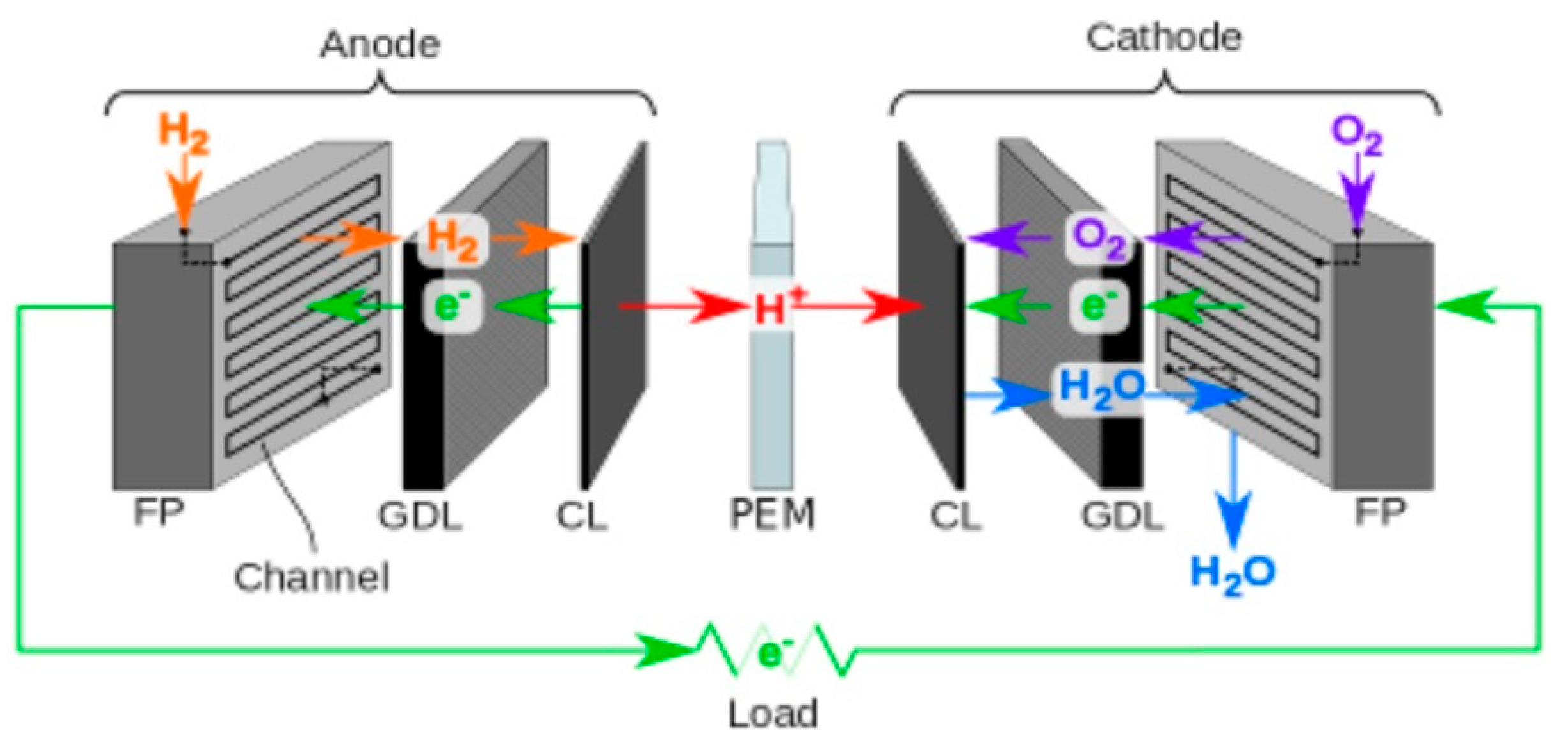




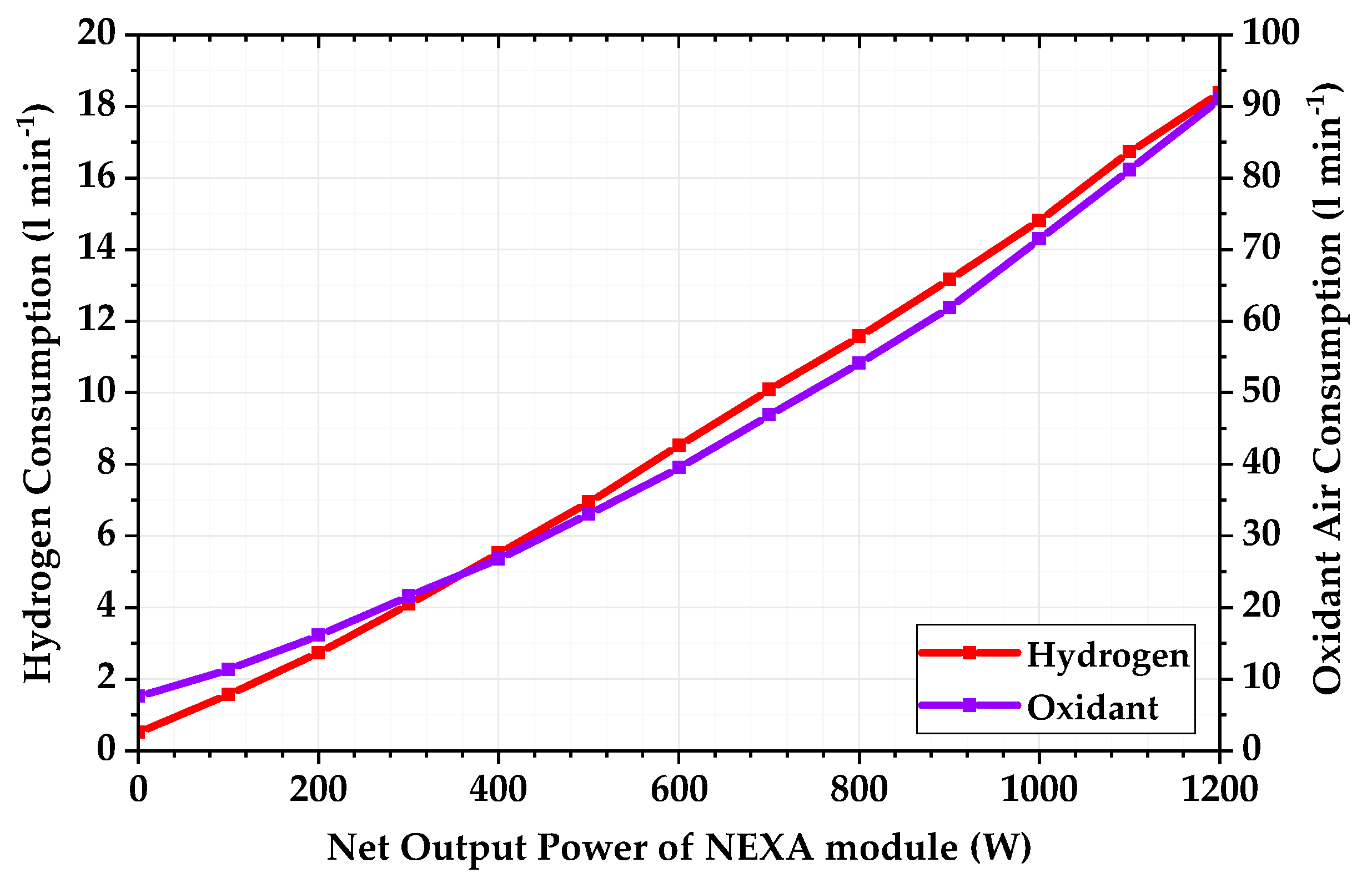


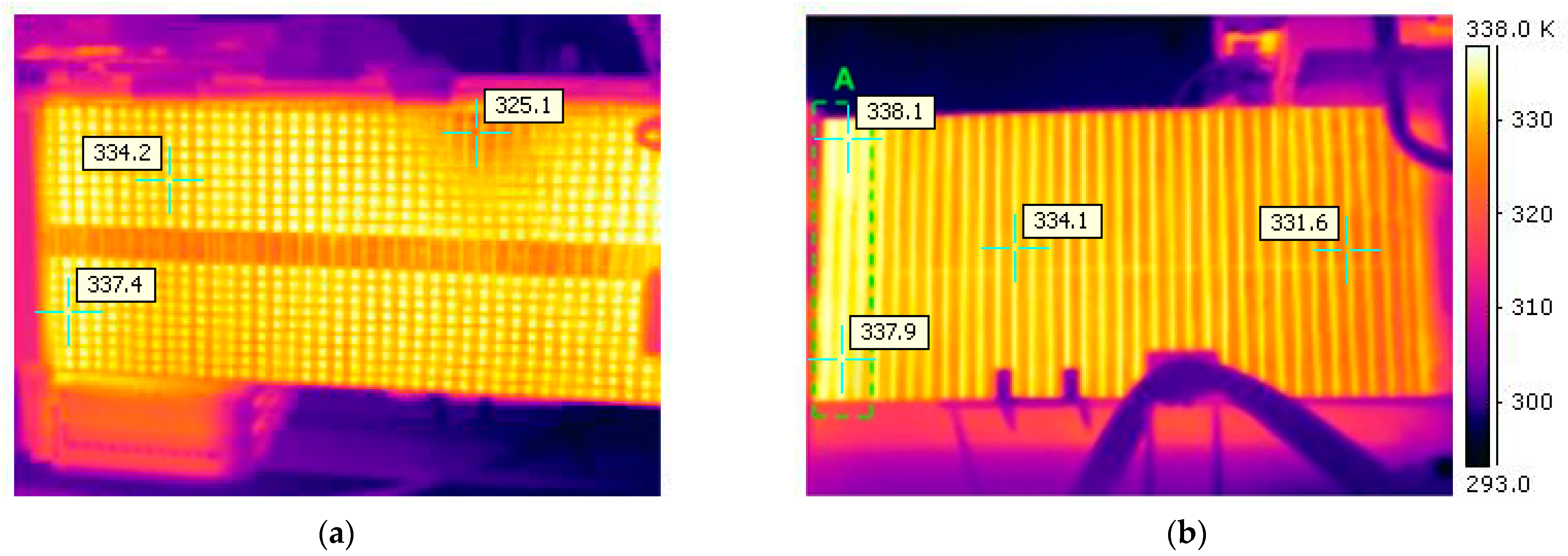
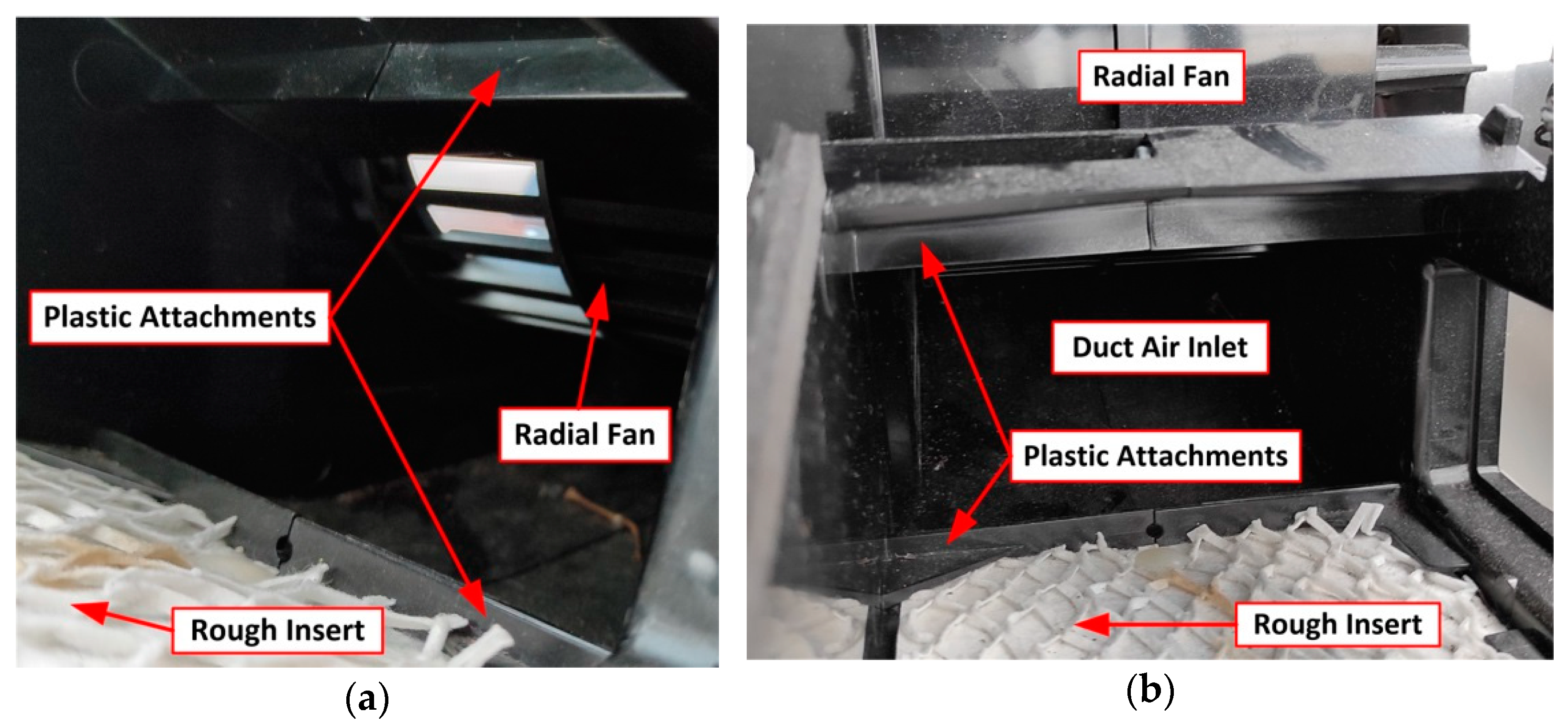
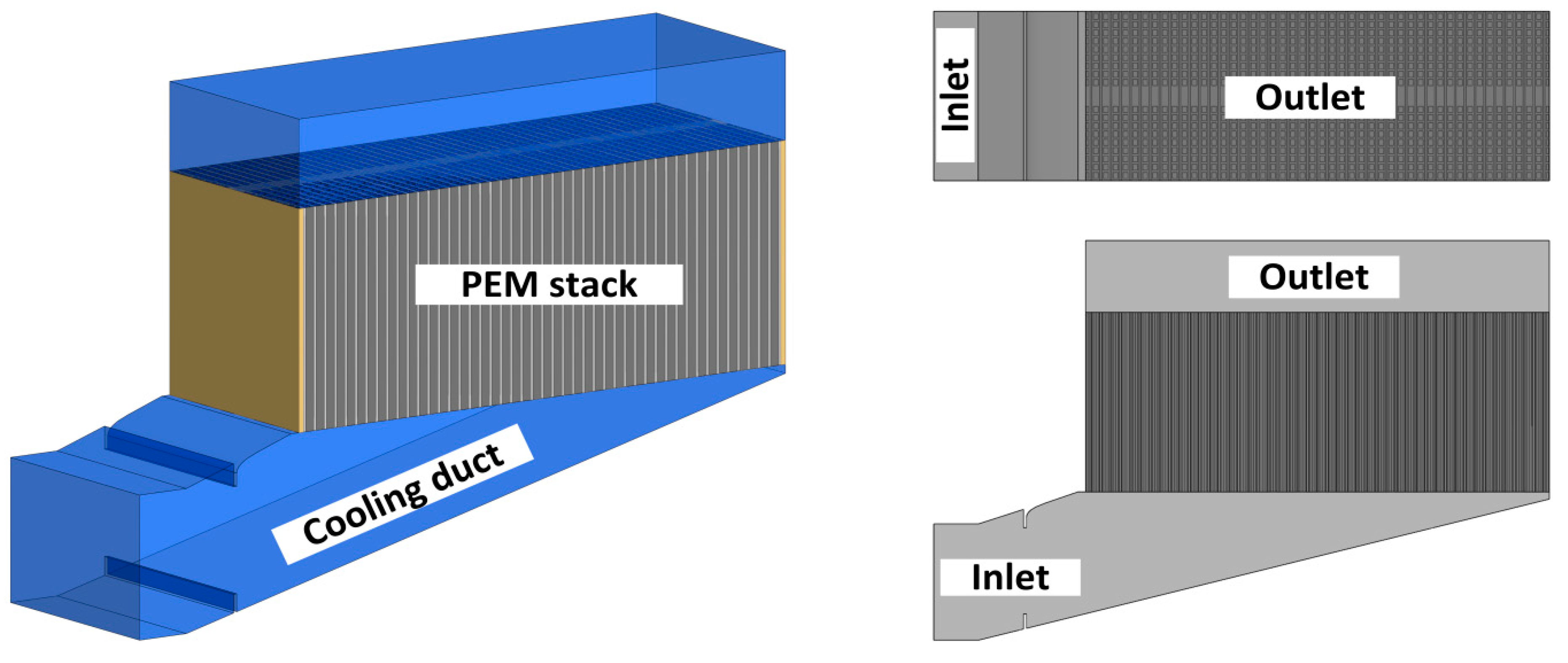

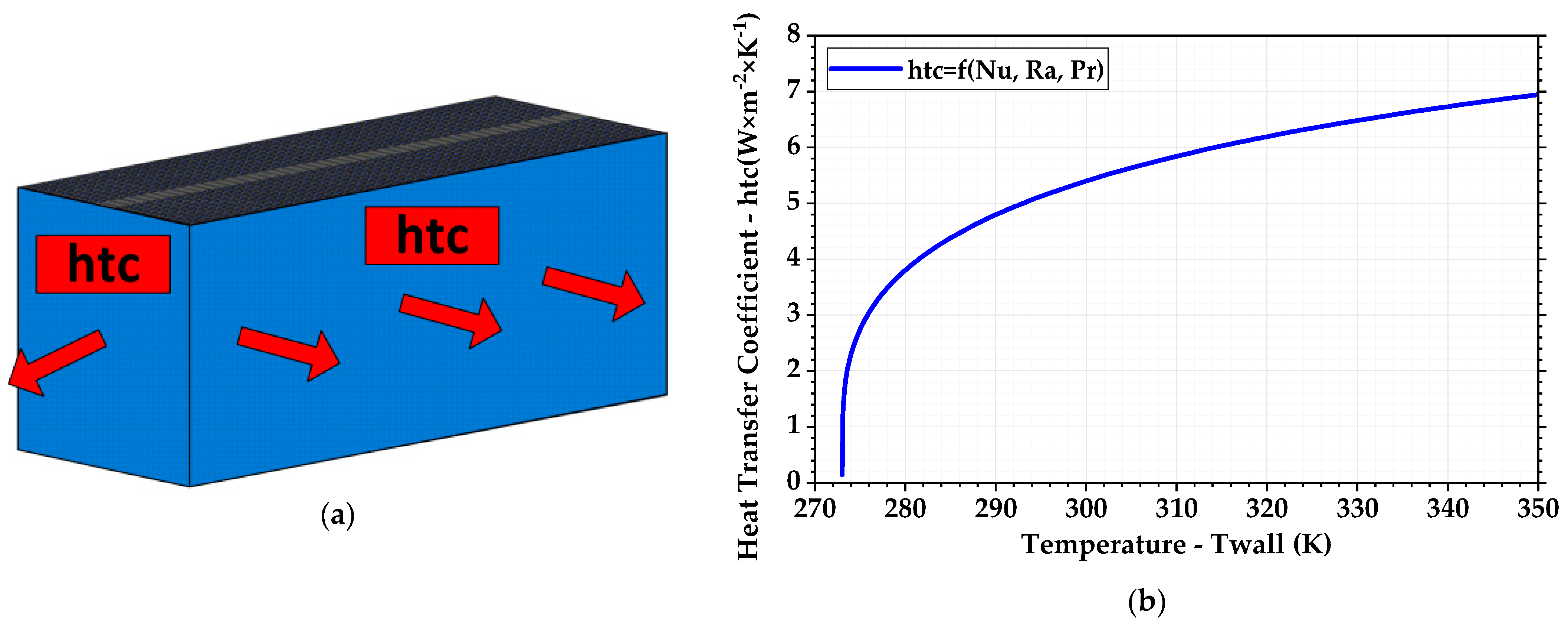
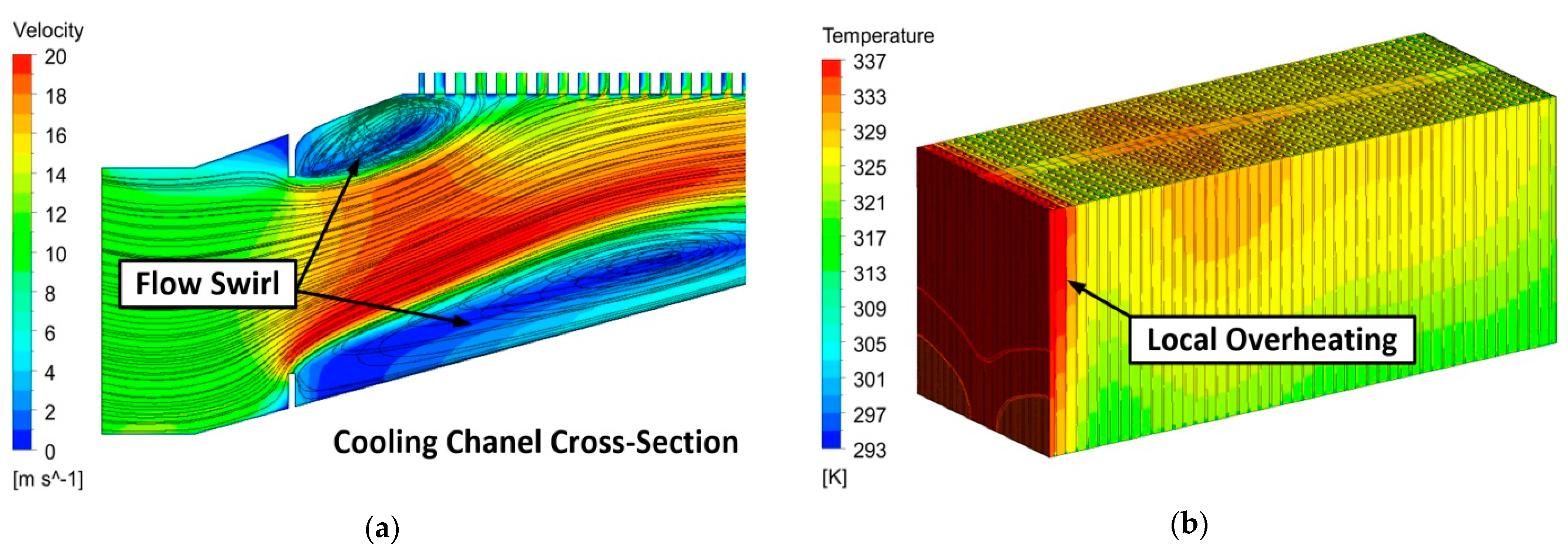


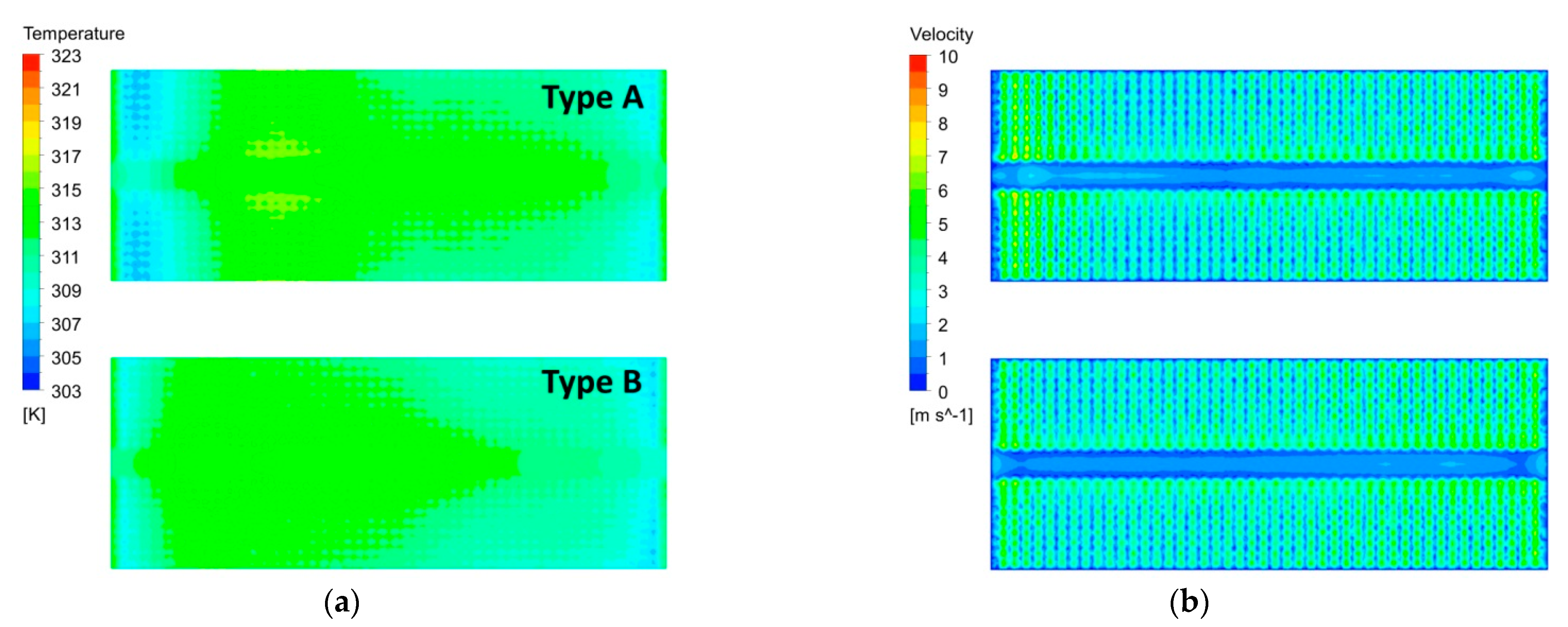
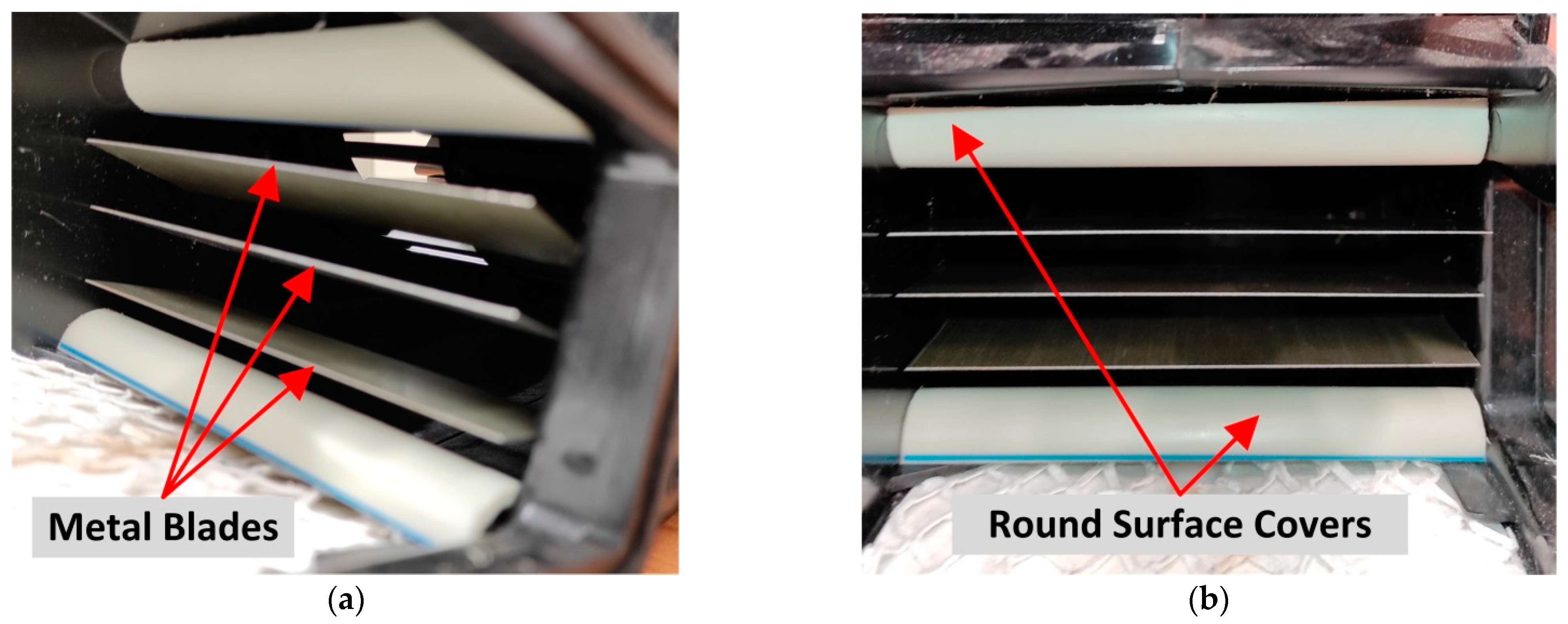
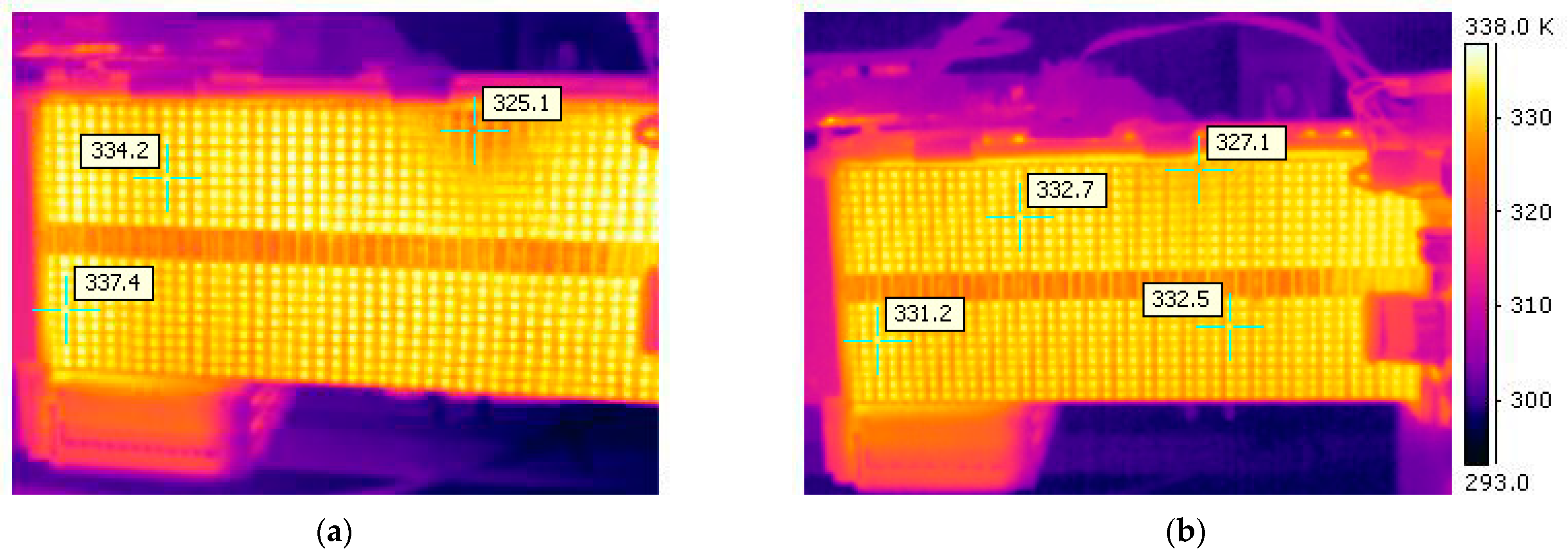
| NEXA Ballard LT PEMFC | |
|---|---|
| Chracteristic | Value |
| Operation Temperature | 65 °C |
| Rated Power | 1200 W |
| Maximum Current I | 230 A |
| Operating Voltage U | 22–50 V |
| Active Area | 120 cm2 |
| Max. H2 Consumption | 18.5 L min−1 |
| H2 Pressure | 70–120 kPa |
| FC Construction Parts | External Plates (Golden Coated) | Cooling Fins (Graphite/Composite) | MEA (Polymer) |
|---|---|---|---|
| Thermal Conductivity, [W (m K)−1] | 318 | 95 | 0.185 |
| Power Losses, [W] | - | 410 | 650 |
| Volume of the Component, [m3] | - | 1.08 × 10−3 | 0.43 × 10−3 |
| Unit Loss, [W m−3] | - | 0.37 × 106 | 1.50 × 10+6 |
| Cooling Duct Modification |  |  |  |  |  |  |
|---|---|---|---|---|---|---|
| Applied Change | Original | Skewed Airfoil | Skewed Airfoil and Blades | Round and Straight Blades | Round Cover and Straight Blades | Round Cover and 3 Short Blades |
| Decreasing of Temperature | - | 0 | 1 | 1 | 1 | 1 |
| Simple Design | - | 1 | 0 | 0 | 1 | 1 |
| Overall Improvement | - | 0 | 1 | 1 | 0 | 1 |
| Final Decision | - | No | No | Yes | No | Yes |
| Type of Modification | - | A | B |
| FC Construction Parts | Original | Type A | Type B |
|---|---|---|---|
| Mass Flow, [kg s−1] | 0.0565 | 0.0565 | 0.0565 |
| Enthalpy Difference—Δh, [J kg−1] | 18,036 | 18,525 | 18,644 |
| Unit Heat in Coolant—Qu, [J s−1] | 1020 | 1045 | 1053 |
| Outlet Average Temperature—Tavg, [K] | 312.0 | 311.8 | 311.7 |
| Outlet Max Temperature—Tmax, [K] | 325.4 | 315.8 | 314.8 |
| Outlet Min Temperature—Tmin, [K] | 301.8 | 305.9 | 306.3 |
| Temperature Uniformity, [%] | 95.8 | 98.7 | 98.9 |
Publisher’s Note: MDPI stays neutral with regard to jurisdictional claims in published maps and institutional affiliations. |
© 2021 by the authors. Licensee MDPI, Basel, Switzerland. This article is an open access article distributed under the terms and conditions of the Creative Commons Attribution (CC BY) license (https://creativecommons.org/licenses/by/4.0/).
Share and Cite
Chesalkin, A.; Kacor, P.; Moldrik, P. Heat Transfer Optimization of NEXA Ballard Low-Temperature PEMFC. Energies 2021, 14, 2182. https://doi.org/10.3390/en14082182
Chesalkin A, Kacor P, Moldrik P. Heat Transfer Optimization of NEXA Ballard Low-Temperature PEMFC. Energies. 2021; 14(8):2182. https://doi.org/10.3390/en14082182
Chicago/Turabian StyleChesalkin, Artem, Petr Kacor, and Petr Moldrik. 2021. "Heat Transfer Optimization of NEXA Ballard Low-Temperature PEMFC" Energies 14, no. 8: 2182. https://doi.org/10.3390/en14082182
APA StyleChesalkin, A., Kacor, P., & Moldrik, P. (2021). Heat Transfer Optimization of NEXA Ballard Low-Temperature PEMFC. Energies, 14(8), 2182. https://doi.org/10.3390/en14082182








